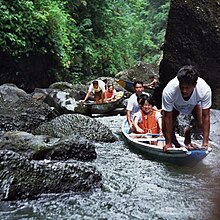Pagsanjan waterfall
The Pagsanjan waterfall (local name: Talon ng Magdapio , "Magdapio waterfall") has a height of 90 m and is located four kilometers east of Pagsanjan in the Philippine province of Laguna . It is one of the most famous waterfalls in the Philippines and one of the greatest tourist attractions in the region. The place Pagsanjan itself was founded in the early Spanish colonial times and is located at the junction of two rivers, the Balanac and the Bumbungan.
General
While the falls are commonly known as Pagsanjan Falls, the locals still refer to them as "Magdapio Falls", named after a man who, according to legend, was responsible for the origin of the falls. In fact, they do not belong to the local area of Pagsanjan, but are in the jurisdiction of the locality of Cavinti . Pagsanjan, the starting point for visiting the falls, is about 92 km south of Manila.
In the summer of 1902, an American Presbyterian missionary, J. Eugene Snook, discovered the Magdapio Falls. After his return to Manila , he wrote down his experiences and referred to the falls as "Pagsanjan waterfall". His story, along with accompanying photographs of the cases, was printed by a popular Manila newspaper, The Cablenews American, making the cases widely known in the cities and provinces of the country then claimed by the United States. For this reason, it is still known today as the Pagsanjan waterfall.
description
The falls caused a heavy flow of tourists to the Pagsanjan area. The falls cannot be reached by land. The only access is the Bumbungan River, which is fed by the falls. From Pagsanjan visitors can be driven upstream to the falls in dugout boats for a fee . The leaders are called "bankers". At non-navigable parts of the river, the guides have to pull the boats over rocky ledges, which is made easier by steel pipes anchored in the rock as a sliding aid. The journey to the destination therefore takes over an hour, while the return journey through the rapids is much faster. Further smaller falls can be seen along the way, feeding the river with water from the left and right. In the rainy season, between August and September, the river carries far more water. The Pagsanjan Falls are bordered by stone cliffs that rise almost 100 m into the jungle and are overgrown with wild orchids , ferns and climbing plants. The water of the falls plunges into a natural pool, in which one can swim and dive. In the water basin, bamboo rafts are prepared, on which the visitors are drawn through the water curtain of the falls into a cave behind it. In the area there are some caves that are known for their acoustics and can be visited.
Legend
Legend has it that the cases did not exist long ago. At that time there was only the highlands covered by primeval forest, the two rivers Bumbungan and Balanac , as well as the delta of alluvial land , in which the village of Pagsanjan extends today. On the east bank of the Bumbungan River lived two old brothers named Balubad and Magdapio. For many years the two enjoyed their humble and peaceful life, before one day a stroke of fate changed their existence. A terrible drought brought death and poverty to the country. For several consecutive months there was no precipitation, so that the soil dried up and the flowers and crops died, which is why the birds, forest animals and wild dogs also disappeared. The rivers, streams and springs also dried up and dried up.
Balubad and Magdapio were hungry and so they prayed day and night that rain would finally come, but God did not answer their prayers. The older and weaker of the two brothers, Balubad, died first, and Magdapio buried him on the slope of a mountain that overlooked the river delta. This mountain has been called Balubad ever since . Now alone Magdapio dragged himself into the higher regions of the dried up river bed until, after an arduous march, he reached the high stone cliffs in the middle of the jungle. But to his great disappointment he found no water here either.
"Oh God!" He groaned bitterly, "where is the water?" Desperate and depressed, he hit his big stick against the rock. Suddenly water gushed from the point where his stick hit the rock. The spring quickly grew larger and the fresh water that came out of the rock face swelled and soon formed a magnificent waterfall. Amazed by this miracle, Magdapio fell on his knees and thanked God for this gift. It is said that this is how the now famous Pagsanjan waterfalls were created.
Web links
Individual evidence
- ↑ a b Pagsanjan (Magdapio) Falls
- ↑ pagsanjan.org ( Memento of the original from May 22, 2009 in the Internet Archive ) Info: The archive link was inserted automatically and has not yet been checked. Please check the original and archive link according to the instructions and then remove this notice.
- ↑ fabulousphilippines.com
- ↑ a b Pagsanjan Falls and rush through the rapids ( memento of the original from June 11, 2012 in the Internet Archive ) Info: The archive link has been inserted automatically and has not yet been checked. Please check the original and archive link according to the instructions and then remove this notice.
- ↑ Key to the cases ( Memento of the original from February 14, 2009 in the Internet Archive ) Info: The archive link was inserted automatically and has not yet been checked. Please check the original and archive link according to the instructions and then remove this notice.
Coordinates: 14 ° 15 ′ 45.3 ″ N , 121 ° 29 ′ 59.9 ″ E

